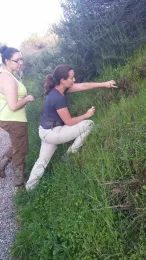Rebecca Godwin'sTrapdoor Spider Presentation Wins a Top Award at ESA Meeting

She studies with major professor Jason Bond, the Evert and Marion Schlinger Endowed Chair in Insect Systematics in the UC Davis Department of Entomology and Nematology.
Godwin delivered her presentation—her first ever at an ESA meeting--on “Phylogeny of a Cosmopolitan Family of Morphologically Conserved Trapdoor Spiders (Mygalomorphae, Ctenizidae) Using Anchored Hybrid Enrichment, with a Description of the Family Halonoproctidae Pocock 1901.”
Godwin competed against nine other presenters in her category, "Graduate Student 10-Minute Presentations: Phylogenetics" (within the ESA Systematics, Evolution and Biodiversity Section).
As a prize winner, she received a year's membership to ESA and a certificate. Overall, the ESA program drew 265 scientific sessions featuring 2,430 oral and 569 poster presentations with presenters from 68 different countries, according to Joe Rominiecki, ESA manager of communications. The submissions in the student competitions totaled 773, he said, adding “A student may enter both the Student 3-Minute Presentation Competition and the Student Poster Competition.”
Godwin's dissertation research deals generally with trapdoor spiders in the family Ctenizidae. “These spiders are distributed across the globe, on every continent but Antarctica,” she noted. “They create silk-lined burrows with cryptic trap doors in which they spend their entire lives. Broadly, I am studying the evolutionary history and phylogenetic relationships among the members of the Ctenizidae, and describing a large amount of previously undocumented diversity along the way. Specifically, my dissertation addresses the monophyly of the family, phylogeography of two genera, Hebestatis and Bothriocyrtum, which occur in the California Floristic Province, and a revision of the genus Ummidia in North and South America.”
The abstract of her ESA presentation:
“The mygalomorph family Ctenizidae previously had a world-wide distribution and contained nine genera and 135 species. However, the monophyly of this group had long been questioned on both morphological and molecular grounds. We use Anchored Hybrid Enrichment (AHE) to gather hundreds of loci from across the genome for reconstructing the phylogenetic relationships among the nine genera and test the monophyly of the family. We also reconstruct the possible ancestral ranges of the most inclusive clade recovered.”
“Using AHE, we generate a supermatrix of 565 loci and 115,209 bp for 27 individuals. For the first time, analyses using all nine genera produce results definitively establishing the non-monophyly of Ctenizidae. A lineage formed exclusively by representatives of South African Stasimopus was placed as the sister group to the remaining taxa in the tree, and the Mediterranean Cteniza and Cyrtocarenum were recovered with high support as sister to exemplars of Euctenizidae, Migidae, and Idiopidae. All the remaining genera—Bothriocyrtum, Conothele, Cyclocosmia, Hebestatis, Latouchia, and Ummidia—share a common ancestor. Based on these results, we elevated this clade to the level of family. Our results definitively establish both the non-monophyly of the Ctenizidae and non-validity of the subfamilies Ummidiinae and Ctenizinae. We formally described the family Halonoproctidae Pocock 1901 and infer that the family's most recent common ancestor was likely distributed in western North America and Asia.”
Godwin holds a bachelor of science degree in zoology (2004) and a master's degree in wetland biology (2011) from Auburn (Ala.) University. She joined the doctoral program at Auburn University in 2016 and transferred to UC Davis this year, joining her major professor Jason Bond, a seven-year Auburn faculty member who chaired the Department of Biological Sciences, and curated arachnids and myriapods at the Auburn University Museum of Natural History.
Godwin will be among those participating in the Bohart Museum of Entomology's open house on "Eight-Legged Wonders" on Saturday, March 9, from 1 to 4 p.m. The Bohart is located in Room 1124 of the Academic Surge Building on Crocker Lane. She was featured in a recent article in the Savannah Morning News, Georgia, on trapdoor spiders.
